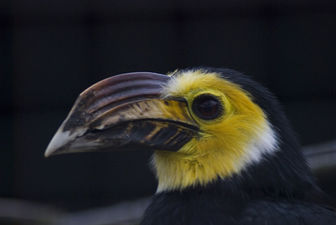Sulawesi Hornbill
An Indonesian endemic, the Sulawesi Hornbill is distributed in the tropical lowland, swamps and primary forests of Sulawesi and nearby islands, from sea-level to altitude up to 1,100 metres. There are two subspecies of the Sulawesi Hornbill. The nominate subspecies, P. e. exarhatus, occurs in northern Sulawesi. The second subspecies, P. e. sanfordi is found in central, east and south Sulawesi, Buton and Muna Island.

Original source: Chris huh
Author: Chris huh
Permission: GNU Free Documentation License
The Sulawesi Hornbill is classified as Least Concern. Does not qualify for a more at risk category. Widespread and abundant taxa are included in this category.
An Indonesian endemic, the Sulawesi Hornbill is distributed in the tropical lowland, swamps and primary forests of Sulawesi and nearby islands, from sea-level to altitude up to 1,100 metres. There are two subspecies of the Sulawesi Hornbill. The nominate subspecies, P. e. exarhatus, occurs in northern Sulawesi. The second subspecies, P. e. sanfordi is found in central, east and south Sulawesi, Buton and Muna Island. The Sulawesi Tarictic Hornbill is a social species that lives in groups of up to 20 individuals. More
The Sulawesi hornbill is endemic to the Indonesian island of Sulawesi and smaller nearby islands. Habitat Red-knobbed hornbills inhabit primary lowland forest and forest edge from sea level to about 3,600 feet (1,097 m) in elevation. They occasionally range up to 5,900 feet (1,798 m) in elevation.Radio-telemetry studies have shown that red-knobbed hornbills may cover as much as 23 miles (37 km) per day, passing through degraded habitat in search of fruiting trees. More
Family : Bucerotidae
Genus : Penelopides
Species : exarhatus
Authority : (Temminck, 1823)

